{{ quickViewProduct.product_title }}
Stock ID
{{ quickViewProduct.product_stock_number }}
Product Features:
- {{ feature.product_feature_description }}
{{ option.product_option_title }}
{{ value.product_option_value_title }}
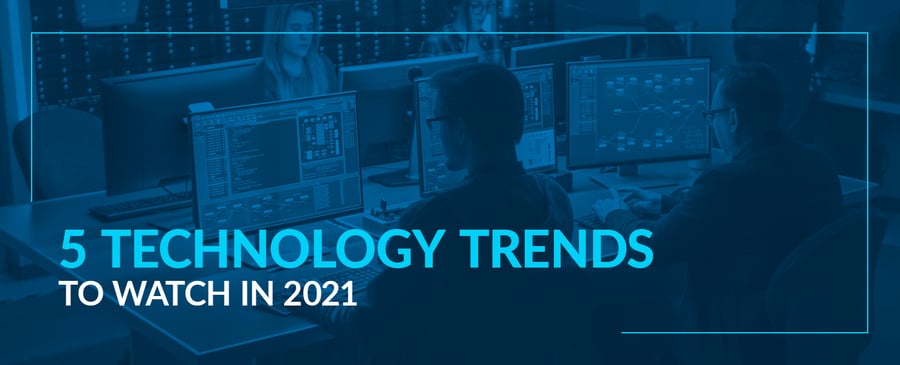
Over the past decade, new tech caused major shakeups that transformed how we live and work. Growing internet access and the rise of smartphones have made mobile essential for business success — and enabled constant connection. Internet of things (IoT) devices transformed the consumer tech market and helped spur what analysts call Industry 4.0, the most recent industrial revolution. Technology trends in 2021 are likely to produce another decade of change.
Companies across the business world are adopting new technology developed in the 2010s. They're finding practical ways to apply it in the form of new initiatives and products. These five technology trends are some of the most pivotal for the coming years, and will likely define how businesses across the economy use tech in 2021.
The rise of data-collection tech, like electronic health records, internet of things sensors and web analytics, often gives companies across industries large datasets — or "big data." This information is incredibly valuable. However, its advantages may be hard to access. These companies are collecting so much data that conventional approaches to analytics can't handle the sheer amount of information they're gathering.
Artificial intelligence — one of the biggest tech trends of the past few years — is excellent at finding patterns and relationships in big data. This analytic ability makes the tech incredibly valuable whenever a company has more information than they can manage.
For example, many logistics companies are using AI to improve their forecasts. An algorithm trained on historical sales data and fed a steady stream of new info can predict consumer demand more accurately than a traditional approach. A hospital may use an AI built for natural language processing to extract critical data from bulky and repetitive electronic health records. Some big-name tech companies, including Google, Amazon and Spotify, are already using AI to improve search recommendations.
Artificial intelligence also enables the real-time analysis of data like audio and video. Self-driving cars and autonomous robotics are two of the best-known examples of tech that need this kind of AI to work.
AI allows self-driving cars to "see" what's coming. Machine vision algorithms draw on a massive video database so the vehicle can break down what's in front of it — road markings, signs, other cars and potential obstacles. The driving algorithm then uses that visual information to decide whether to brake, adjust the steering wheel or accelerate.
These cars are just one example of how the business world plans on using the tech soon. Manufacturers are using the tech to provide real-time analysis of their factories and equipment. Some companies are also beginning to develop AI chatbots to help customers when their service representatives are busy.
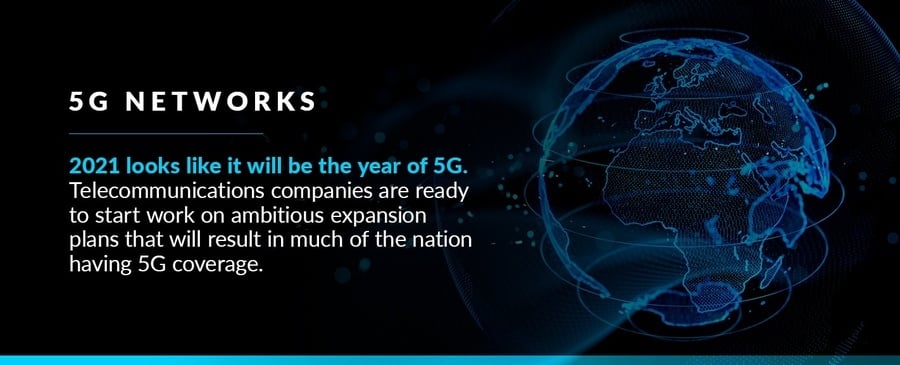
5G, the successor to 4G, was initially on track to roll out toward the end of 2019. However, the push to build 5G infrastructure hit roadblocks in the low adoption of 5G-compatible tech and a regulatory battle between the FCC and weather forecasters.
Major telecommunications providers were on board to fully launch the tech in 2020 and made some significant process in expanding 5G coverage. For the most part, however, they had to put their plans on hold again.
Now, 2021 looks like it will be the year of 5G. Telecommunications companies are ready to start work on ambitious expansion plans that will result in much of the nation having 5G coverage. At the same time, there's enough 5G-compatible tech to make the infrastructure worth it. New 5G routers and phone modems are finally on the market. Big-name tech developers — like Apple — are also considering adding 5G compatibility to their newest devices.
So, what is 5G? Why are businesses so keen on making the switch from 4G to this new tech?
For devices that need to respond quickly to new information or user input — like a self-driving car, or a surgical robot that mimics a surgeon's hand movements — latency can be a matter of life and death. Even a delay of a few milliseconds may result in an accident. Even in less dramatic situations, latency can cause severe issues, or defeat the purpose of implementing a "real-time" monitoring solution.
5G does a few different things to solve this problem. To start, it's much faster than the previous generation of telecom tech. 5G uses a much wider band of the spectrum than 4G. That means network operators can use more bandwidth to transfer data. 4G speeds max out at a theoretical 100 megabits per second. 5G download speeds, in theory, can go as high as 10 gigabits per second — that's 100 times faster than 4G. If a device needs to send or receive a massive amount of data, transmission speed is much less likely to create congestion than it is with 4G.
5G also integrates multiple-input/multiple-output. This new tech makes individual cell towers much better than 4G at handling large numbers of simultaneous connections. For example, if a factory has hundreds or thousands of IoT sensors collecting and transferring data, a 4G tower may struggle to serve all those devices concurrently. 5G also solves this bottleneck by multiplying the number of antennae on individual towers.
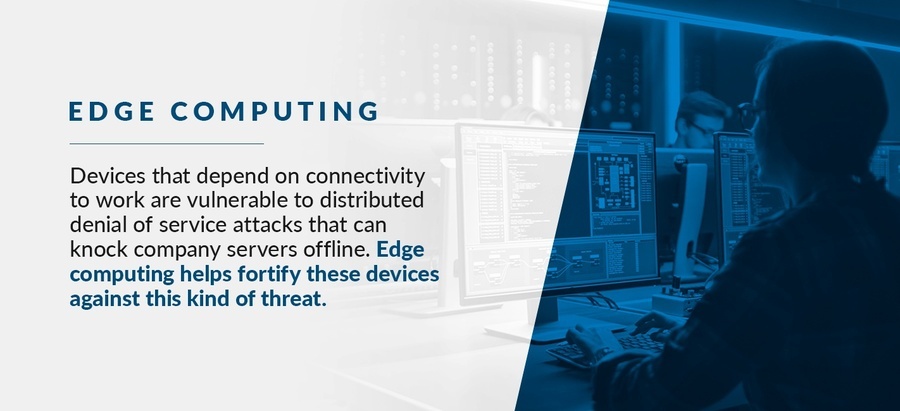
For some devices, the speed boost of 5G doesn't cut down latency enough. The time spent waiting for a signal to travel to the cloud and back may be too much.
Not every calculation needs to travel back to the cloud. With edge computing, companies move some of the work smart devices need to do closer to the gadgets themselves.
They accomplish this in two ways. First, they design those devices to handle some of that work on their own. They also create nodes at the edge of the network with enough processing power to manage specific requests. If a device can't process an operation itself, but doesn't need the cloud's full power, it may send its request to an edge node.
This approach helps further cut down on latency, making IoT tech even more reliable.
Minimizing the transfer of data between devices and the cloud can, however, complicate security somewhat. A centralized or cloud-based network is often easier to secure than one that includes dozens or hundreds of edge nodes. If companies aren't diligent, edge nodes could be a risk. By the same token, the less often you transfer data, the less vulnerable it will be to man-in-the-middle attacks. Edge computing may make data more secure as a result.
Edge computing may also make IoT devices more functional if they don't have access to the cloud. Devices that depend on connectivity to work are vulnerable to distributed denial of service attacks that can knock company servers offline. Edge computing helps fortify these devices against this kind of threat.
Virtual reality and augmented reality, both likely to be trending technologies in 2021, use digital imagery to transform a user's environment.
Augmented reality (AR) adds virtual elements to a live view. The technology typically accomplishes this with a smartphone or tablet camera, but more advanced applications may use a specially designed headset. In some cases, this may be digital imagery. Construction workers, for example, are beginning to use AR in the field to see how a finished building will look. They may also use the tech to know exactly where to put a vent or pipe in a given room.
In other cases, a business may use AR to create a heads-up display that offers some additional information about their environment.
A combination of consumer and business devices that use AR will likely be available next year. For instance, Apple could be aiming for a 2021 release of the company's new smart glasses, dubbed Apple Glass. According to a Bloomberg report, these glasses will have AR functionality that will beam information from a smartphone directly into a heads-up display.
Mercedes-Benz also plans to use AR in the company's new 2021 S-Class Sedan. A digital display on the windshield will offer drivers information like time, speed and distance between them and the car ahead.
Virtual reality (VR) takes the ideas behind AR further. Unlike AR, VR uses a headset to shut out reality entirely and immerse the user in a fully digital environment. With handheld controllers and motion-tracking devices, the user can move through and interact with objects within the virtual reality.
So far, the entertainment industry has been one of the most enthusiastic adopters of VR. Multiple major tech companies — Facebook, Sony, HTC and game developer Valve — have released proprietary headsets and peripherals designed for video games, digital chatrooms and other VR entertainment software.
While its most remarkable successes have been in the consumer market, VR is also likely to be one of the defining technology trends of 2021 for businesses. Tech like BadVR, for example, allows business analysts to step inside a virtual visualization of their data.
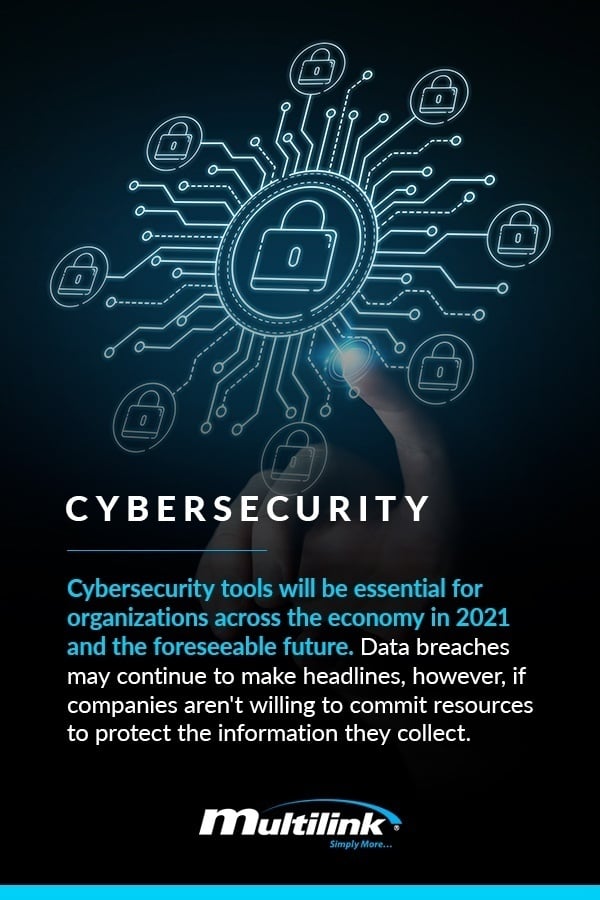
All the data companies are collecting isn't only of interest to them. Much of this information is also extremely valuable to hackers and other cybercriminals.
Over the past few years, the number of cyberattacks every year has only trended up. The average cost of these crimes is also steadily rising. According to data from cybersecurity firm Radware, the average cost of an attack in 2018 and 2019 was $1.1 million — a 52% increase over the cost in 2017 and 2018.
The rise of security breaches has created a raft of new issues for the companies who have been slow to adopt new cybersecurity tech.
Organizations of all kinds are at risk. Data breaches suffered by big-name companies — such as Marriott, Nintendo and MGM — tend to make headlines. However, any institution that collects personally identifying data may be a target. For example, local governments are finding themselves increasingly under attack by ransomware, a kind of malware that holds files hostage until the victim pays up. Schools are facing hackers who seek student and faculty data to sell on the dark web.
Even data that may not seem immediately valuable to hackers — like medical data — often has its uses, such as Medicare fraud.
The increasing complexity of business networks also makes them more challenging to secure. Most businesses, for example, are adopting new cloud tech. If misconfigured, the cloud can be a major security vulnerability. According to IBM, attackers used cloud misconfigurations to breach networks 20% of the time, significantly increasing the overall average cost of these attacks.
A major portion of these attacks involve a technique called phishing, in which a hacker impersonates a trustworthy source to convince an individual to divulge information or download a malicious file. Better cybersecurity training — along with advanced tools that can detect and quarantine potential phishing emails — can help businesses beat these attacks.
Cybersecurity tools will be essential for organizations across the economy in 2021 and the foreseeable future. Data breaches may continue to make headlines, however, if companies aren't willing to commit resources to protect the information they collect.
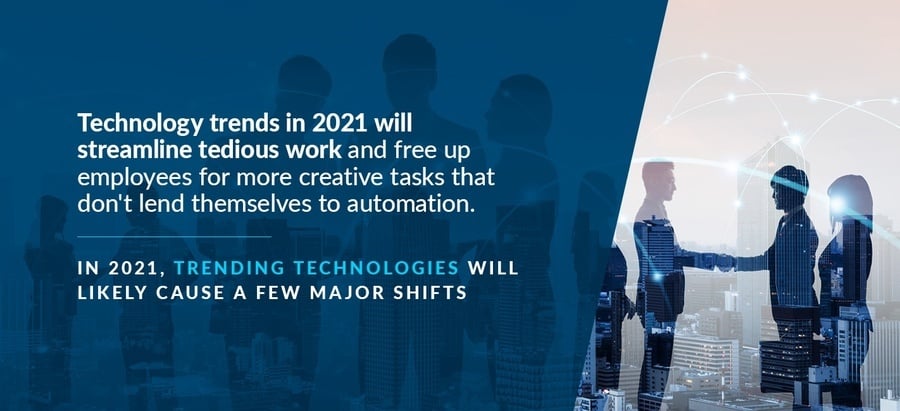
In 2021, trending technologies will likely cause a few major shifts.
First, IoT tech is likely to become even more valuable — especially for businesses interested in adopting large fleets of IoT sensors. 5G will streamline the transmission and reception of data. A growing pool of AI analytics and data processing tools will help companies turn that data into usable insights. The increased reliability of connections will also make remote monitoring and access technology more practical.
5G will also make autonomous cars and robotics — along with other devices that need lightning-fast connections to the cloud — significantly more practical than they are now.
Despite the significant number of labor-hours these innovations are likely to save, it's unlikely that these new, automated tools will replace jobs. Instead, companies will look to new technology to assist their workers. We've already seen this in manufacturing, where factory owners have pivoted away from fully automated factories and toward collaborative robots designed to work alongside human workers.
It's likely that instead, technology trends in 2021 will streamline tedious work and free up employees for more creative tasks that don't lend themselves to automation.
All these new devices will also present some major potential security vulnerabilities for companies. Every IoT device and edge node, if not properly secured, is another angle of attack a hacker can use to gain access to a business' secure networks.
The increasing collection of operational and consumer data will also make companies more vulnerable to hackers.
Cybersecurity professionals and new security tech will become essential, even for organizations — like schools — that haven't traditionally had to worry about cyberattacks.
If you want to be ready for 2021, you need to know about the most promising tech trends. AI, edge computing, VR, AR and the coming rollout of 5G technology are likely to define this coming year. Multilink is a leader and innovator in the telecom industry, and our range of 5G products can prepare businesses for this changing world and take full advantage of these new trends.
Back to Multilog